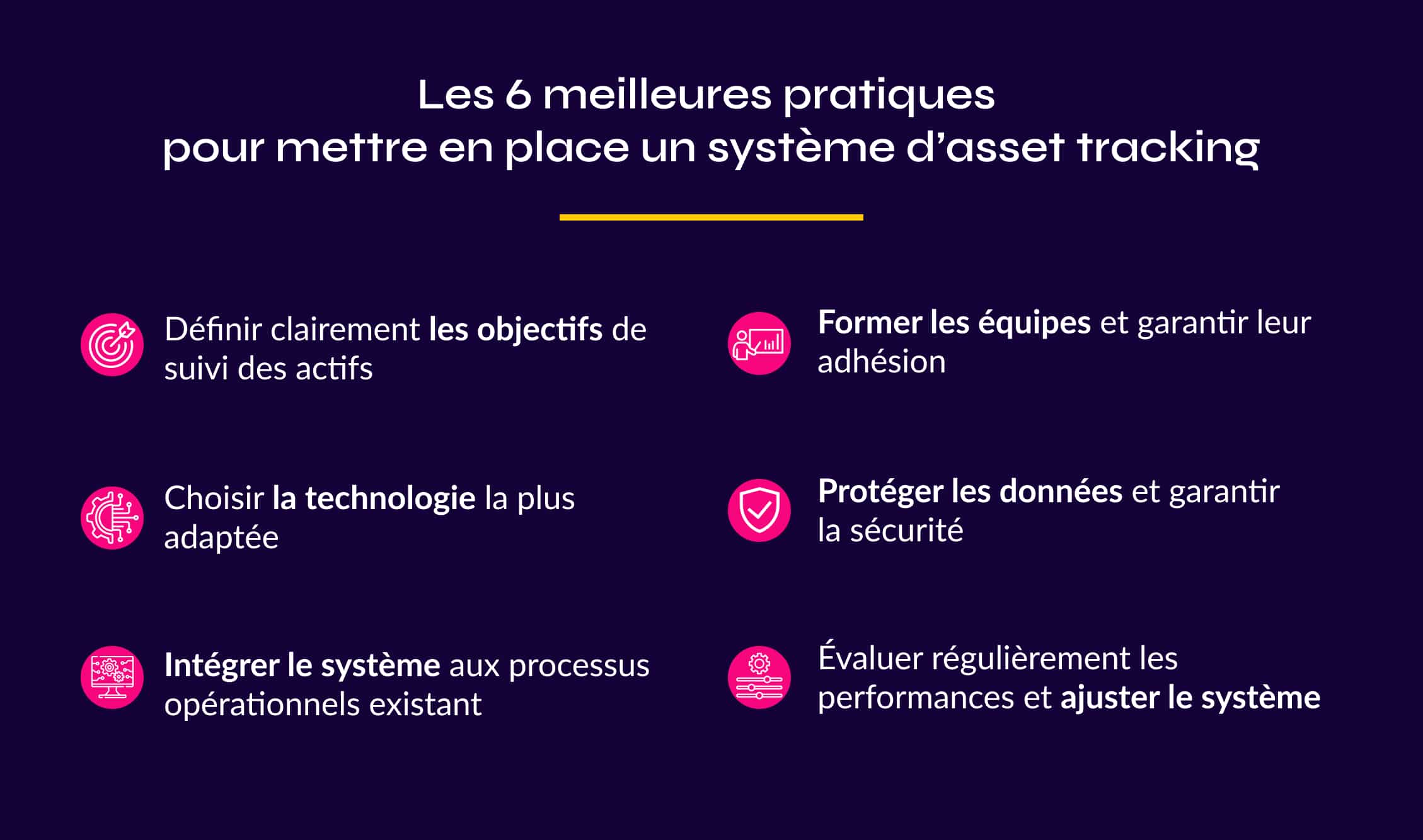6 best practices for setting up an asset tracking system with indoor geolocation
Share this article
Contents
Share this article
Thanks to indoor geolocation technologies, it is now possible to efficiently track and manage equipment, goods or even people in complex environments such as warehouses, hospitals or factories. However, successfully implementing an asset tracking system requires a structured and strategic approach. Here are 6 best practices for optimizing your indoor asset tracking project.

1. Clearly define asset monitoring objectives
The first step in a successful project is to identify specific needs and operational objectives:
- What types of assets should be tracked?
This includes tools, equipment, inventory and even vehicles. - What results do you expect?
Reduced waste, optimized travel, improved maintenance, etc.
- Which KPIs should be monitored?
For example, mean time to location or equipment availability rate. To find out more about the main KPIs to use in your asset management strategy, we recommend this article.
A clear framework from the outset will help prioritize essential functionalities and guide technical and budgetary decisions.
2. Choosing the most appropriate localization technology
The choice of technology is decisive for system performance. Here's an overview of the main options available.
RFID
Simple, cost-effective asset identification, but with limited accuracy in complex environments.
BLE (Bluetooth Low Energy)
Balanced cost and performance, particularly useful for areas requiring approximate location.
Wi-Fi
Takes advantage of existing infrastructures, although accuracy depends on network density.
UWB (Ultra-Wideband)
Highly accurate, ideal for mission-critical environments. Requires extensive infrastructure and high investment.
WHEERE
The only technology that can cross obstacles and cover an entire site with just four antennas, with an accuracy of less than one meter.
3. Integrate the system into existing business processes
The effectiveness of an asset tracking system depends to a large extent on its ability to integrate seamlessly with existing processes. Successful integration ensures that the data collected by the system does not remain isolated, but forms part of an overall operational and strategic logic.
Connect the system to existing management tools
To take advantage of the real-time data collected by asset tracking, it is crucial to link it to existing management systems, such as :
- ERP (Enterprise Resource Planning): Provides a centralized, real-time view of your assets, while facilitating their management at organizational level. For example, location data can enrich maintenance, logistics or financial management modules.
- WMS (Warehouse Management System): By integrating asset tracking into the WMS, you can improve inventory management and optimize the flow of goods in warehouses, notably by reducing search and travel times.
- MES (Manufacturing Execution System): In production environments, connection to an MES enables real-time monitoring of equipment status, production cycles or raw material movements.
Using geolocation to automate key processes
Automation is a major lever for reducing human error and improving efficiency. The integration of the geolocation system enables intelligent automation, such as :
- Preventive maintenance alerts: using thresholds linked to equipment use or location, you can automate alerts to avoid costly breakdowns.
- Automated movement tracking: Locating critical assets in real time helps optimize workflows, for example by automatically guiding operators to the equipment they need.

4. Train teams and secure their commitment
The adoption of an asset tracking system depends not only on its technological relevance, but also on its acceptance and use by teams. Good training and clear communication are essential to overcome any resistance and ensure optimum use of the system.
Raising team awareness right from the design phase
Involving employees from the outset of the project is essential to ensure their buy-in.
- Present the project as a beneficial solution, not as a constraint. Explain clearly how the system will improve their working conditions (for example, by reducing time wasted searching for equipment, or by making their tasks easier).
- Involve them in the solution selection process. Involving representatives from different departments in the testing or demonstration phases can reinforce their sense of ownership of the project.
- Get their feedback. Their comments can help you adapt the system to better meet their real needs.
Offer adapted and progressive training courses
Training is a key factor in ensuring optimum use of the system. For it to be effective :
- Tailor content to user profiles. Managers will need to understand reporting and analysis, while operators need to focus on basic functions such as searching or updating data.
- Combine different learning formats. Use hands-on workshops, video tutorials and written materials to cater for different learning styles.
- Focus on short, targeted sessions. Rather than lengthy theoretical training sessions, opt for short modules focusing on concrete use cases.
Create intuitive, ergonomic interfaces
The system's ease of use plays a key role in its adoption:
- Simplify the user interface. Essential functions should be accessible with just a few clicks.
- Offer online help tools or FAQs. For example, a knowledge base or chatbot to answer frequently asked questions.
- Customize dashboards. Providing each user with an interface adapted to his or her responsibilities makes for greater efficiency and clarity.
Transparent communication, appropriate training, ergonomic interfaces and long-term support are the cornerstones of successful adoption.
5. Protecting data and guaranteeing security
The adoption of an asset tracking system depends not only on its technological relevance, but also on its acceptance and use by teams. Good training and clear communication are essential to overcome any resistance and ensure optimum use of the system.
Implement advanced security protocols
The first step in securing your data is to implement robust technical measures:
- Data encryption: All data, whether in transit or stored, must be encrypted using recognized security standards (such as AES-256). This ensures that even in the event of interception, information remains unreadable to unauthorized third parties.
- Multi-factor authentication (MFA): Strengthen access to systems with authentication in two or more steps (password + code sent to a device or dedicated application).
- Regular software updates: Keeping your systems up to date protects against known vulnerabilities. Work with suppliers who offer rigorous tracking of security patches.
- Isolation of sensitive data: Critical information, such as that linked to strategic assets, must be isolated on secure servers or in partitioned environments.
Ensuring regulatory compliance and transparency
Asset tracking systems must comply with local and international data protection laws. To this end :
- Comply with the RGPD (or other local regulations): In Europe, this means, in particular, collecting and processing data solely for legitimate purposes, guaranteeing its confidentiality and enabling the users concerned to exercise their rights (access, modification, deletion).
- Limit data collection: Reduce the amount of data collected to what is strictly necessary to limit the risks in the event of a breach. For example, collect only location information without unnecessary details.
- Document your practices: Keep a register of data processing operations and implement clear policies for their management. In the event of an audit, complete documentation will reinforce your credibility.
- Keep stakeholders informed: Whether it's your employees, partners or customers, make sure they understand how their data is used and protected.
Monitor and anticipate threats with proactive tools and audits
Cybersecurity is an evolving process that requires constant monitoring and adjustment:
- Perform regular audits: Schedule periodic checks to identify security vulnerabilities and ensure that your protocols remain effective in the face of evolving threats. Call in external experts for in-depth penetration testing.
- Implement Intrusion Detection Systems (IDS): These tools monitor network activity and report any suspicious behavior or unauthorized access attempts in real time.
- Opt for regular, secure backups: In the event of a cyber-attack or technical failure, frequent backups will enable you to quickly restore your data. Make sure these backups are also encrypted and stored in a separate location.
- Anticipate emerging threats: Stay up to date on new cybersecurity trends, such as ransomware attacks or the exploitation of IoT (Internet of Things) vulnerabilities, which can target asset tracking systems.
6. Regularly evaluate performance and adjust the system
An asset tracking system should not be seen as a static project, but rather as a dynamic tool that evolves with business needs and technological advances. Regular evaluation of its performance helps to identify weak points, maximize return on investment (ROI) and keep the system up to date with new operational requirements. Here are two key points for effective monitoring.
Monitor and analyze key performance indicators (KPIs)
Collecting and analyzing the data generated by the asset tracking system enables us to assess its effectiveness and operational impact. The following indicators are particularly useful:
- Mean asset location time: Measures how easy the system is to find equipment or goods. A significant reduction in this time indicates an operational improvement.
- Asset utilization rate: Identifies under-used or unused equipment, enabling more efficient redistribution or maintenance planning.
- Reducing loss or theft: A high-performance system must reduce the number of lost or stolen goods through improved traceability.
- Return on investment (ROI): Compare the costs of implementing and maintaining the system with the financial gains it generates (time savings, loss reduction, etc.).
Actions to be taken :
- Set up a centralized dashboard to visualize KPIs.
- Organize periodic reviews to analyze data.
- Combine user feedback with KPIs to complement quantitative analysis with a qualitative perspective.
Test and integrate new functionalities and technologies
Asset tracking is a fast-moving field. To remain competitive, it is essential to adopt a proactive approach to continuous improvement:
- Evaluate technological developments: Keep abreast of new solutions available, such as more powerful algorithms or emerging technologies (e.g. artificial intelligence or predictive analytics).
- Test new functionalities: Conduct pilot tests before integrating new features on a large scale. For example, if a new geofencing or alert automation feature becomes available, measure its impact on your processes before rolling it out globally.
- Working with the supplier: A solution like Wheere can offer specific updates or enhancements to suit your needs. Involve your supplier in performance monitoring and ongoing system optimization.
Successful asset tracking: the importance of 360° vision
Setting up an asset tracking system with indoor geolocation is more than just a technological choice. As the six best practices developed in this article illustrate, building a solid, high-performance, scalable asset tracking system requires a methodical approach and a strategic vision that takes into account all aspects of the business, and all project stakeholders.
Did you like it?
Share it and discover other articles you might also like!
- News
- News
- Articles

